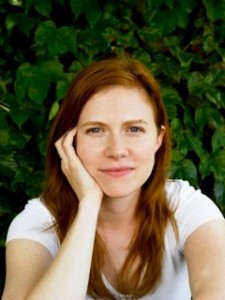
Margaret Lazarus Dean: photo credit Joe Vaughn
Margaret Lazarus Dean’s The Time It Takes to Fall takes place in the early 80’s in Cape Canaveral, a space town, during a time when NASA and shuttle launches were still a part of the American story of success. The main character of the novel, Dolores Gray, is an exceptionally bright student who is determined to be an astronaut when she grows up. Dolores’s father works as a technician for NASA, and he takes Dolores to every shuttle launch, the details of which Dolores then meticulously records in her space journal, her scrapbook of all things NASA.
Dolores has also recently found herself befriended by Eric Biersdoffer, the son of NASA’s Director of Launch Safety, the smartest, but also most unpopular boy in school. Dolores’ struggle between her desire for popularity and her secret love of math and science make life difficult for her. However, her life becomes even more trying when her father’s job at NASA is threatened along with her parent’s marriage. Then, when the Challenger explosion occurs on the morning of January 28, 1986, a launch that had been highly anticipated as it was the first launch ever to include a teacher in its crew, her world turns completely upside down. And Dolores not only makes it her goal to figure out what went wrong on the launch, but also hopes that by doing so she can both save her father’s job and bring her family back together again. Seeking out difficult answers to difficult questions becomes part of the process of growing up for Dolores, whose loss of innocence mirrors America’s loss of faith in space travel.
 Since meeting Margaret ten years ago at the University of Michigan, where she received her MFA in 2001 and subsequently taught writing before accepting her current position at the University of Tennessee in Knoxville, I have been impressed by how much she has lived inside this project. From her intense knowledge of NASA trivia to her set of NASA drinking glasses to her astronaut kitchen magnets, she has immersed herself in this world. She even enrolled willingly in a physics class for the summer so that she could do the space math needed in this novel. But this book goes beyond the NASA facts to make a universe full of memorable places and characters that deeply move me, and I wanted to hear more about what went into creating characters against the backdrop of such a tragic historical event.
Since meeting Margaret ten years ago at the University of Michigan, where she received her MFA in 2001 and subsequently taught writing before accepting her current position at the University of Tennessee in Knoxville, I have been impressed by how much she has lived inside this project. From her intense knowledge of NASA trivia to her set of NASA drinking glasses to her astronaut kitchen magnets, she has immersed herself in this world. She even enrolled willingly in a physics class for the summer so that she could do the space math needed in this novel. But this book goes beyond the NASA facts to make a universe full of memorable places and characters that deeply move me, and I wanted to hear more about what went into creating characters against the backdrop of such a tragic historical event.
Interview:
I’ll start off with the most obvious questions. Why NASA? Why the Challenger? And why NASA and the Challenger now?

Challenger Explosion: January 28, 1986
I’ll take the second question first: the idea of writing about Challenger was the impetus for the book from the beginning. I remember seeing that disaster and thinking, this is the worst thing that has ever happened—and it was, for people in my generation, the worst thing we had ever witnessed. This was a disaster that affected children more than it did adults, because we (children) were sold on the excitement of having a schoolteacher on board. Within a few weeks, adults seemed to have adopted the attitude that this was very sad, but it was the price of progress, yet children were still walking around with this look of betrayal in their eyes. We had been told that spaceflight was so safe they could send up a schoolteacher, and then they blew it up, with the schoolteacher on it, while we were watching live. We did not bounce back as quickly.
I’d been interested in NASA and spaceflight since I was a little kid, largely due to the Smithsonian’s Air and Space Museum. My father took my brother and me there on visitation weekends starting when I was seven, so I’ve been there approximately one million times. Visiting this museum a lot as a kid was really a great education—I have a lot of images and impressions in my head, knowledge acquired in a disorganized way, which I think is good for fiction. I can close my eyes and picture the lunar modules that put the astronauts down on the moon, or the spacesuits, or the little packets of food they ate. Of course, all this was before the shuttle program got going, so in a weird way I was more familiar with Apollo-era spaceflight, which took place before I was born, than I was with the space shuttle era, which didn’t start until I was nine.
But I think it was useful to see and believe in spaceflight in this way, through artifacts rather than through books or learning it at school. The idea that these were things designed by people, that it was people who went to space, is crucial to the way I think about NASA, and is strangely missing from the way a lot of people think about spaceflight. I don’t think you can believe in a lunar hoax conspiracy theory, for instance, if you are really aware of the huge number of people who worked on each of these missions.The idea that they weren’t actually doing what they were purported to have been doing, that they would all keep this dark secret, is ludicrous. You can only believe that if you picture NASA as this faceless, inhuman entity. And I think that human quality is crucial to the way I portrayed NASA in the book—the rockets were assembled by people, and one of those people was Dolores’s father.
 Why NASA and Challenger now? I didn’t intend it to be particularly timely; early in my attempts to write something good, I seized on this material and my own memories of what happened, and the more I learned about the disaster the more convinced I was that I wanted to write about it. I did experience some doubt in September 2001, when a disaster of completely different proportions occurred. I wondered whether readers might ever again be stirred to care about a disaster that had killed only seven people—all of them people who had accepted the risk of this inherently dangerous undertaking. As a tragedy, it pales in comparison to 3000 normal people dying in office buildings and on planes. But I came to believe that writing about a smaller disaster was still worthwhile, because it’s still true that Challenger was the worst thing that had ever happened for kids in our generation, and as such it still bears looking at. I’m also interested in the way that disasters all have certain things in common, the way that literature about disasters has certain common themes, even if the disasters are deeply different, which is why I obsessively read fiction and nonfiction about 9/11, about Katrina, about the Triangle Shirtwaist Factory fire in 1911, about Columbine.
Why NASA and Challenger now? I didn’t intend it to be particularly timely; early in my attempts to write something good, I seized on this material and my own memories of what happened, and the more I learned about the disaster the more convinced I was that I wanted to write about it. I did experience some doubt in September 2001, when a disaster of completely different proportions occurred. I wondered whether readers might ever again be stirred to care about a disaster that had killed only seven people—all of them people who had accepted the risk of this inherently dangerous undertaking. As a tragedy, it pales in comparison to 3000 normal people dying in office buildings and on planes. But I came to believe that writing about a smaller disaster was still worthwhile, because it’s still true that Challenger was the worst thing that had ever happened for kids in our generation, and as such it still bears looking at. I’m also interested in the way that disasters all have certain things in common, the way that literature about disasters has certain common themes, even if the disasters are deeply different, which is why I obsessively read fiction and nonfiction about 9/11, about Katrina, about the Triangle Shirtwaist Factory fire in 1911, about Columbine.
There is a definite awareness that this is a novel about space, even in the imagery as the opening prologue offers us a birds-eye view of the Florida landscape and by the epilogue that view is so complicated: then we’re clearly looking down through the eyes of the astronauts. I love this theme of “watching from above” throughout, though it’s eerie to think about.
Thanks, that’s a cool way of reading it. I didn’t think consciously to start with this helicopter shot of central Florida and then moving back up into the sky again at the end, but I guess that has a nice symmetry, accidentally.
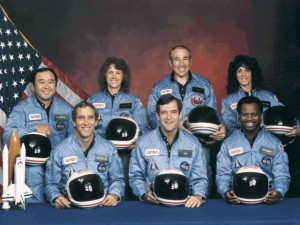
Challenger Crew: photo from NASA website
I did assume, for most of the time I was working on the book, that I wouldn’t ever enter the astronauts’ point of view, because that seemed fraught with ethical issues. They are real people, and they are dead and so can’t speak up for themselves if they don’t like what I’ve written. But the more I learned about the disaster, the more I learned about the seven people on the Challenger crew, the more I came to genuinely like them, and that made me more comfortable entering into a scene with them. Plus, the more I learned about what they experienced that day, especially in those minutes after the explosion, the more I thought that scene needed to be part of the book.
I find myself so visually enticed by so many of the elements in the novel, from the mother’s hair to launch-side bleachers to the schoolyard. I feel like you direct my eye so specifically. I know fiction should “show” but your way of showing is so vivid and precise—as if images could attach us to a past or place for good. Did you intend to be so visual? For example, there’s that scene in the book which I recall as vividly as if I had been there. The mom is in the backyard refinishing the table because they are having important dinner guests, and she’s quite a sight. Here a quote from the passage:
. . .her forehead tight, [she] squinted meanly at the table, moving her lips now and then. She wore yellow rubber gloves up to the elbows and a set of pink pajamas. Our father had shrunk them in the wash and the sleeves came to just past her elbows, the bottoms strained over her hips. The top with its lace edging was now streaked with red wood stain in a way that seemed obscene. Her hair escaped from her ponytail in frizzy black drifts that hung in her eyes and swayed to the rhythm of her work.
That’s a nice thing to say about it, thanks. I didn’t consciously think about the style as being especially visual—I think I wrote this way partly because my own memories of being a child are intensely visual. I remember staring at things until they sort of defamiliarized and took on outsized level of detail, especially in stressful or traumatic situations. So it just made sense to me for Dolores to see things that way too. I also like the way visual descriptions can take on so much emotional and thematic weight without feeling overly weighty.

Recent Shuttle Launch: Photo Credit Margaret Lazarus Dean
I’m always telling my students to take advantage of the things that literature can do that other art forms, especially film, cannot, and this is one of them: we can inflect descriptions, whereas movies can only show physical objects more or less as they are. I can describe a pack of cigarettes or a space shuttle as my character would see it, as distinct from the way anyone else in the world would see it. And not only that, I can describe it as she would see it on this particular day, at this particular moment in her life. (Incidentally, this is why Lolita can never be made into a film successfully—because Humbert’s descriptions of Lolita are so inflected through his pedophilia and his love for her. You can’t point a camera at a 13-year-old girl and have that produce the same effect as his descriptions, because the camera can never see her the way that he does. That can only be constructed through language.)
How did that impulse toward imagery relate to the Challenger explosion, which was truly a visual icon? Or how did it feel to write about such an iconic image?
Yeah, I think most people remember the Challenger disaster as a visual image, and for people in our generation, who were kids at the time, it’s sort of burned into our brains. In terms of using it in the book, I think it was actually more difficult to write about an image that everyone already knows so well. I sort of imagined that readers would be anticipating that image as the story approached that point, but also not wanting to be bored by reading a description of something they’re already very familiar with. At the same time, some readers, like my youngest siblings, were not around for that and don’t have that image filed away, so I couldn’t depend on that to be in the reader’s mind either. I think the key I discovered to making it work was the inflection thing I was talking about earlier—to write about that moment in a way that would feel specific to that character’s experience, not just anyone’s.
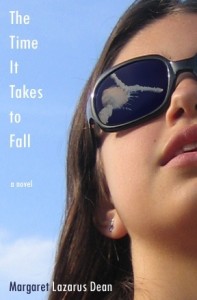
Early Cover Design
As a side note, an early proposal for the book’s cover included the image of the explosion, and I’m glad that we didn’t wind up going with that. I think that smoke signature should kind of lurk in the imagination rather than sitting on the cover of the book.
The final cover I felt reflected the novel perfectly with the child-like stars. It reminded me of one of the pages of Dolores’ space notebook. Did you enjoy writing from a child’s perspective? What choices did you have to make in choosing that kind of unreliable narrator?
I did enjoy writing from the point of view of a child, because children are so perceptive but are also often overlooked, which makes them great narrators. I wanted Dolores to be unreliable in certain ways, but not in others, which is not as tricky as it might sound. She’s always right on about math, science, and the details of spaceflight, but doesn’t always understand the emotional dynamics around her, especially her parents’. I hope readers will understand that intuitively.
Some readers have been put off by Dolores, by her honesty and imperfections (for instance, that she doesn’t always behave honorably). I think people are used to children being portrayed as very good and innocent, a purer version of adults, and that’s just not the case. I like Dolores and I think she’s a good kid, but her being a child doesn’t mean she isn’t sometimes selfish or mean.
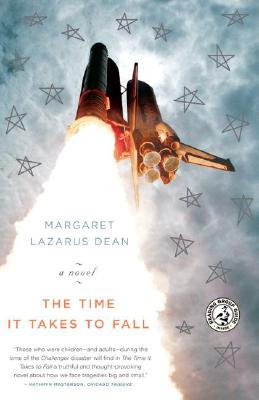 I assigned your novel as part of my first-year writing class and my students really connected to it. In honor of them I thought I would ask the question that they often asked, the question I used to hate because it seemed too unliterary, but that I learned to love because it showed how connected they felt to the individuals: “Why did the characters do this thing and not the other thing?” (This was often followed with “They should have or shouldn’t have done that.”) Did you ever imagine different endings for Dolores?
I assigned your novel as part of my first-year writing class and my students really connected to it. In honor of them I thought I would ask the question that they often asked, the question I used to hate because it seemed too unliterary, but that I learned to love because it showed how connected they felt to the individuals: “Why did the characters do this thing and not the other thing?” (This was often followed with “They should have or shouldn’t have done that.”) Did you ever imagine different endings for Dolores?
I think it’s an interesting question, because it goes deep to the heart of the craft of fiction. What are the things that we can decide for our characters, and what are the things we have to wait to hear about from them? I think when I write I make a few key decisions about characters early on, and then I feel pretty helpless after that. I started this book with the idea that it would revolve around the Challenger disaster, and that children were more affected by it than adults. So Dolores is thirteen. Then I found a couple of ways to make her more affected by it than most kids would be—her father is laid off from his job at NASA as a result of the disaster, there is some suspicion that he might have been at fault in some way, and her own dream of becoming an astronaut is crushed. Having set these things in motion for her (and having made similar key decisions about other characters) I couldn’t then move her and the other people around like chess pieces. I had to follow them and find out what happened rather than making it up. Which was sometimes very frustrating.
I often hear writers use these expressions about their characters, like “He up and ran off and got into this crazy mischief!” as if our characters are naughty children. And that sometimes sounds kind of cheesy and contrived to me, but I think what I’m saying here is the same thing—once you set them in motion, you’re sort of running after them taking notes, rather than making their decisions for them.
I don’t know what kind of “should have” comments you hear—the one I hear most often is that Dolores shouldn’t have had sex with Josh [an older boy, in a scene that depicts an encounter that is technically statutory rape]. And that makes me try to untangle the way we use “should have”—because I agree that she “shouldn’t have” in the sense that it wasn’t a wise decision, but I insist that she would have, and did, and that it’s to the benefit of the story that she did.
That was definitely one of the “shouldn’t haves.” What else do you want readers to consider about these characters that you lived with for so long? Do you want us to forgive them or understand more subtle motives that underlie what we see on the surface?
I like questions about the characters because I came to really like these people, and I sort of miss them, so it’s fun to get to talk about them because it’s like I get to visit with them a bit. I really like the questions like “What ever happened to __?” even though they make no sense. A lot of people ask me if Dolores ever became an astronaut, what happened with Eric Biersdorfer, stuff like that. The questions can’t be answered, but I like the way the questions imply that readers have come to believe in these people beyond what they see on the page, because I do too.

Florida: Photo Credit Margaret Lazarus Dean
Of all the characters, I think I’m still most interested in Deborah, Dolores’s mother, because she changed the most for me over the years I worked on the book. I had the idea early on that she would be involved in these machinations, only half understood by Dolores, to try to get Frank’s job back, and that made her sort of a cartoonishly conniving figure. I went through a process with Dolores similar to the one many writers do when writing creative non-fiction— the first versions were somewhat exaggerated to show Dolores’s perception of her, but as I got further into the book, I kept wondering, why does this woman seem so one-dimensional? And the answer was: Oh yeah, it’s that I’m not considering any sort of life or even consciousness for her outside of her function in the plot. I had to force myself to take a closer look at her and think about her motivations—why would she behave the way she does? What are the things that make her real, rather than being just a figure in Dolores’s life? What was her childhood like, what does she think about when her husband is at work and her kids are at school? Now that I’m a mother, I’m more aware of the way that mothers often get treated as large appliances, both in literature and in life, and that makes me glad I decided to take some extra time with Deborah to figure her out a bit more.
It’s funny to think of mothers as large appliances! You did a great job making Deborah very real. Even when she is absent in the novel she seems real. Do people ever wonder if this novel is autobiographical?
When the book first came out, I reacted pretty snottily to the question, “How much of the book is autobiographical?” (Although that is apparently a lot of people’s favorite question for an author.) I dismissed that as the least interesting way to read fiction—trying to match it up with some “truth”—and I also felt (and still do) that it’s more rudely intrusive than askers seem to realize. These people were essentially asking me, “Did your mother ever cheat on your father to try to help him get his job back? Did you have sex with an adult as a 13-year-old to try to establish your own identity?” To which the answers are: no, and also: wow, none of your business.
But I’ve been forced to be a little less snotty about this recently, because there is one person who I stole from real life for the book, whom I hadn’t seen for more than twenty years, and that person subsequently became my Facebook friend. And when he was like, What have you been up to? Looks like you wrote a book! Maybe I’ll check it out!, I panicked. And I thought: It turns out I’m a huge hypocrite. I won’t tell the whole story here, because I’m working on an essay about it, but it’s interesting to reflect on the way I always just rejected that autobiography question without having to admit that the characters I create, by necessity, are based on what I know of people, and that is based, by necessity, on the people I have known.

Florida: Photo Credit Margaret Lazarus Dean
One of the things that draws me in again and again to this novel is that it’s a period piece of a period for which I have some fondness: the 80s. The period details aren’t overly blatant or gimmicky at all, but I love when I am reminded that this is America in the 80s. I could even feel in the novel how the characters, and even the houses, cling to the 70s in their sad way while trying to be up-to-date. Even though this is a disaster novel did you enjoy writing about all that cool 80s stuff like the pop music and the shoes?
I did enjoy that—it’s been weird seeing the 80s come back into fashion again, in a way that I really don’t connect to my own experience of being alive then. It bothers me (and fascinates me) that we’ve chosen to see this era as one huge joke about neon stretch pants and synth pop. I’m not sure why it is that for some eras the music and fashion and cultural obsessions that survive are the most innovative and profound, but for the eighties we’ve chosen to remember it as cheesy and emptily self-important. But I don’t think it’s possible that people are smarter or dumber in certain historical eras (I say this over the objections of those who came of age in the sixties and have enshrined the superiority of that era in what I believe to be a very self-congratulatory way). There must be some sort of national shame about the things that were going on in the eighties for us to be so mocking of that time.
But, yeah, in the book I would often work on chapters for long periods of time without thinking specifically about the era, and then looking at it again I’d feel like I should eighties it up a little bit. But that’s a delicate thing to do—you can’t just hand your character a Rubik’s cube and put white sunglasses on her and call it a day. I had to really try to separate the stereotyped ideas that have developed since then from my actual memories of what people wore and how they talked. At the same time, some clichés are clichés because they are true, and I wanted to be honest about those things as well. Like, I do remember wearing black leggings with a huge T-shirt and boots and thinking the combination was quite fetching.
After the book came out, I was asked to make a playlist of music related to the book and write about it for a music site called Largehearted Boy, which was actually a great opportunity for me to reflect on the music of that time and opine about it a little bit. Some of the songs I wrote about there are songs everyone knows because they’re on the 80s compilations, but some of them aren’t, and it was nice to reflect on mix of music that Dolores might have listened to. It also gave me a chance to try to articulate my love for Prince, which can never truly be articulated.
I know you did a lot of research to get Florida right, but how important was it to get these artifacts right?

Florida: Photo Credit Margaret Lazarus Dean
Super important. I always sort of imagined a Florida native reading the book and saying, “She’s clearly not from here.” And this was the standard I tried to hold myself to, though it’s sort of an impossible one—to satisfy someone who lived where my characters lived and worked where they worked, for it to feel completely real to them. Place is very important to me, and I felt like a trespasser in many ways writing this book—I kept imagining if someone who grew up in Florida tried to set a book in Minnesota, how I would react to that, and the answer was: probably not kindly. If I could have moved this story to Minnesota, I would have, but unfortunately for me, Cape Canaveral cannot be moved.
So I did a lot of research, and I visited the area twice (and got to see a space shuttle launch), but ultimately, I relied a lot on imagination, and I wish the word “imagination” did not have such childish and unserious associations, because it’s hard work and it should be taken seriously.
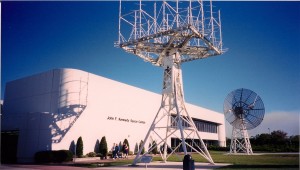
Kennedy Space Center: Photo Credit Margaret Lazarus Dean
I have heard from a number of readers who grew up in that area, including one reader who grew up there in a NASA family, still lives there, and now has a job working on the space shuttle at the Kennedy Space Center himself—so he’s sort of like my nightmare of a reader. He politely pointed out a couple of inaccuracies, but he’s generally a fan of the book and has invited me to visit for an insider tour. So I kind of passed the test.
The idea of “getting it right” seems to be a theme throughout the novel. And it seems to be deeper than your average need to be respected or fit in as the novel also brings in math, something that can be “gotten right” in a definite way. What does it mean for these characters to get it right?
I think most of the characters in the book are pretty committed to “getting it right” in the ways that count to them—except for Delia, whom I love for that reason. The dad of course is also interested in “getting things right” at his job and at home: I think he’s meticulous about his work, and never forgets that people will be riding on the rockets he’s working on. He also really tries to be a good father, and I think he is. But he doesn’t have a sense of trying to “get it right” for his own gain, of trying to reach for something beyond what he currently has. Maybe this is another way of saying that Dolores and her mother are ambitious and he is not, and now that we’re talking about it I think this is one of the things some readers find off-putting about Dolores and especially the mother—that they are ambitious and it shows. They try to make things happen for themselves rather than just waiting politely. It’s interesting, because this is a quality I think Americans tend to value and admire a lot, but it can also easily tip in the wrong direction and then we really punish that person for it.
Talk about getting it right—the mall! The characters say that though “they didn’t talk about it” the mall changed the way they live. You nailed that mall. The way we didn’t talk about it, but it was so huge. Even the way there were the strip malls and then there was the mall. We analyzed the passage about the mall to death in class because I love it so much. It seems to mirror the novel’s progress. Please talk about the mall.

The Mall: Photo Credit Margaret Lazarus Dean
The mall is one of those things that generally gets treated like a joke, a joke about adolescence or a joke about the eighties or both, but it’s an interesting experiment in fiction to try taking things seriously that we are supposed to be flip and mean about. What are we trying to hide by being so flip? What’s in there that makes us uncomfortable that we turn mean?
My own experiences of visiting malls when they first started to appear in the eighties was not at all like Dolores’s—I lived in a suburb of a big city at that time, so we had a lot more options than the Grays did for shopping, eating, and generally getting out of the house, including smaller, seventies-style malls. But I imagine that in small towns like the one where Dolores lived, the introduction of the big mall would really transform their lives, how they spent time as a family, what they ate for dinner. I also remember really acutely the dire importance of having the right clothes at Dolores’s age (twelve and thirteen). Adults are surprisingly condescending about adolescents’ interest in clothes—but that interest is not nearly as much about materialism or status as adults seem to think. I think it’s more about having the power to construct your own appearance, to look on the outside like the person you want to become. Anyway, the mall is where clothes happen, so I wanted to reflect the importance of that for Dolores too.
I had a note in my notebook for a long time to return to the same mall years later, in the nineties or early 00s, when it’s grubby and dated and maybe even a little dangerous. But there was never a cause to jump that far forward in time.
Speaking of jumping forward, what about your future work? Does your next novel take on any other disaster themes?
Why yes, it does! The novel I’m working on now takes place in the late nineties and early 00s, and it has to do with the year 2000 disaster, which many people prepared for but never happened, and 9/11, which no one was prepared for and did happen. I’m interested in the contrast between those two and how they have shaped our thinking about disaster in our era.

Kennedy Space Center: Photo Credit Margaret Lazarus Dean
For Further Reading:
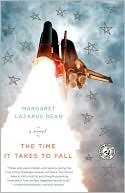 If you’re interested in good fiction that deals with disaster, Margaret recommends the following: Haruki Murakami’s novel After the Quake (earthquake in Kobe, Japan); Lorrie Moore’s novel A Gate at the Stairs and Martin Amis’s story “The Last Days of Mohammed Atta” (terrorist attacks of 2001); Ann Patchett’s novel Bel Canto (Japanese embassy hostage crisis in Lima, Peru), and Katharine Weber’s novel Triangle (Triangle Shirtwaist Factory fire).
If you’re interested in good fiction that deals with disaster, Margaret recommends the following: Haruki Murakami’s novel After the Quake (earthquake in Kobe, Japan); Lorrie Moore’s novel A Gate at the Stairs and Martin Amis’s story “The Last Days of Mohammed Atta” (terrorist attacks of 2001); Ann Patchett’s novel Bel Canto (Japanese embassy hostage crisis in Lima, Peru), and Katharine Weber’s novel Triangle (Triangle Shirtwaist Factory fire).
For more on The Time It Takes to Fall, here is a 2007 review from Blookslut. You can also visit the author’s homepage for more links to reviews. Or follow the author on The Time It Takes to Blog.
Also be sure to read Margaret’s wonderful interview with famed blogger Mimi Smartypants, which FWR published last August. Here is as excerpt from the introduction to their conversation:
Readers are constantly being reminded that the act of reading is dying out, with “reading” being defined as “reading books published in the traditional manner.” And one of the forces cited as driving us away from the endangered Book, of course, is the Internet. But I always wonder: what does it mean that time spent on the Internet is largely time spent—well—reading? Like many writers, I do a lot of my reading on the Internet as well as in published books, and one of my favorite writers right now is a Chicago woman we know only as Mimi Smartypants. She has been writing an online diary since 1999, and in over 1000 posts she has detailed her everyday life, sharing with the world (anonymously) anecdotes about public transportation, meditations on the workings of her own psyche, and accounts of the joys and frustrations of raising her daughter, Nora, now a kindergartner.





